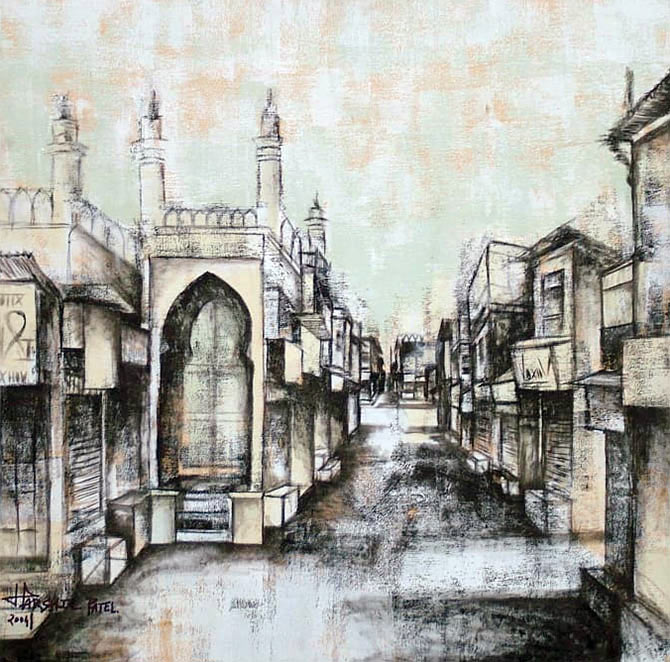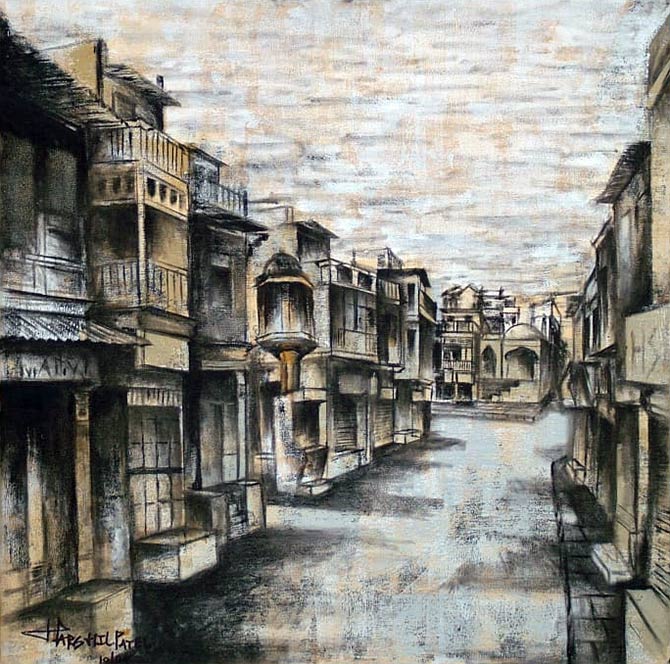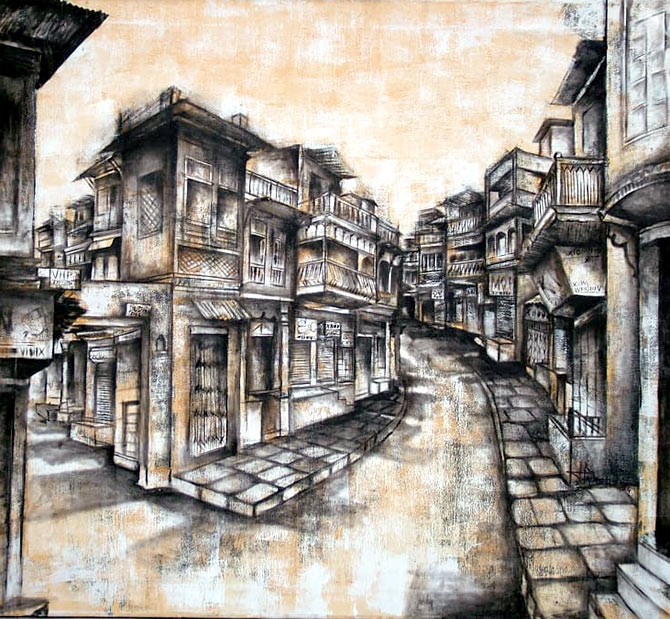Winner of the Lalit Kala Akademi award, Ahmedabad-based painter and photographer Harshil Patel offers a fantastic view of the walled city in Ahmedabad through his paintings and photographs for US President Donald J Trump.
He also talks about the most interesting places within the walled city that POTUS will miss out on during his three-and-half hour stay in Ahmedabad, which only covers a visit to the Sabarmati Ashram and inauguration of the world's largest stadium, both on the outskirts of the main city.
Patel, who specialises in heritage and historical perspectives of Ahmedabad, says the city has failed to conserve its rich cultural and architectural heritage. About his paintings and photographs, he says, "I love to explore the city at night. I imagine I am having a conversation with Ahmed Shah (the founder of the city as it exists now) and based on his description of the city that he built I do my paintings."
Explaining the importance of shades of darkness that his art is influenced by, Patel says, "I find it important to play around with black and white colours. I love shooting pictures at night because I love the shades the night creates under dim lights. The night for me is representative of our past and the day represents the present. I love using black and white because they add the right perspective and depth to my paintings."
"I love shooting pictures at night because the streets are empty. There is no disturbance. I get the silence I need to communicate with my subjects. Importance and emphasis is on the heritage of the buildings."
Harshil Patel spoke with Prasanna D Zore/Rediff.com on where he would have taken the President of the United States in Ahmedabad were he in Prime Minister Narendra Damodardas Modi's place.
***
Ahmedabad has been declared as India's first World Heritage City by UNESCO. Very few cities in the world can be called walled cities. Ahmed Shah built a wall around the entire city. The Gandhi Ashram (along the banks of the Sabarmati river) and the Motera stadium (the world's biggest stadium with a seating capacity of 110,000) lie outside the boundaries of the walled city.
Not only as an artist but also as a resident I wish President Donald Trump visits the walled city, its narrow streets that reminds one of Venice and Florence.
POTUS should have visited, or whenever he visits next, the historical Teen Darwaza, Manek Chowk, which is considered the place from where the city began to flourish and spread, and Bhadra Fort. He should also spend some time along the Sabarmati river front, which he might get to see when he visits Gandhi the Ashram.
If I were in Prime Minister Modi's place I would have taken President Trump to the place from where the city originated -- Manek Chowk -- and from there taken him around the city to show him the city's expanse and reach.
Ahmedabad has 13 darwazas in all from where one can enter or exit the city. I would have taken him on a tour of all 13 gates. I would have shown him the socio-cultural fabric, which is the soul of any city, of Ahmedabad. It is the culture that breathes life and soul into a city's identity.
I would have also taken POTUS to the many step wells that Ahmedabad is so famous for.
***
Here then is an artistic impression of Harshil Patel's Ahmedabad which he shared with Rediff.com:
Relief Road, or, Pir Mohammad Shah Road, Old City, Tankshal, Kalupur, Ahmedabad

I used green tone to bring out the influence of Muslim culture that surrounds the area. I created a texture of the old wall in the background using multiple layer of colours to show how old the neighbourhood is.
I like to work with black tones to show depth of history and love to play with shadows and light. Painting: Kind courtesy Harshil Patel
Pankore Naka, Old City, Khadia, Ahmedabad

This area is well known for various markets that have come up in this locality since the 14th century.
Naka means the corner of a street in Gujarat. The different shapes of houses and shops showcase the confluence of not only Hindu and Muslim assimilation, but one can also witness the influence of European, Portuguese and Gothic styles of architecture.
I have drawn this panoramic perspective to show the grandness of space. Painting: Kind courtesy Harshil Patel
Dariyapur, Old City, Ahmedabad

Astodia, Old City, Khamasa, Ahmedabad

Ashawal was the first name of Ahmedabad in the memory of the Bhil king Asha. Later the city was named Karnavati when King Karnadev defeated the Bhil king. Painting: Kind courtesy Harshil Patel
Sarangpur Chakla, Sherkotda, Ahmedabad

Ghee Kanta, Old City, Bhadra, Ahmedabad

The peculiarity of this neighbourhood is that most people have their residence above and shops on the ground floor. Painting: Kind courtesy Harshil Patel
Lambeshwar ni Pole, near Calico Dome, Ahmedabad

The purpose of designing these narrow streets was to confuse the soldiers of the invading armies that would get lost in the labyrinthine maze that these narrow streets are. Painting: Kind courtesy Harshil Patel
Manek Chowk, near Bhadra Fort, Ahmedabad

The construction of the wall began from Bhadra Fort. Ahmedabad was once named Karnavati and ruled by Karnadev during the Solanki era.
After defeating Karnadev, Ahmed Shah began to build a wall around the city. The place where we have Manek Chowk now was inhabited by saint Maneknath who had magical powers.
A great worshipper of Lord Shiva, Maneknath Baba would meditate on the banks of the Sabarmati which once flowed through the middle of the city. He did not like Ahmed Shah building a wall around the city because he believed a city should not be walled but remain open and free to assimilate and absorb influences from outside.
So, while the workers would construct the wall during the day time, through his magical prowess, Maneknath Baba would demolish the wall at night.
When this began to happen regularly and without any clue about how an invisible force was destroying the wall at night, Ahmed Shah asked his spies to find out who was demolishing the wall at night.
When his spies reported to him about Maneknath Baba's magical prowess, the king asked him why he was destroying the wall.
The sagacious Baba told the king that he was restricting the city's development by walling it from all the sides.
While the wall was built because the king wanted to build it to protect the city from enemies, after serious deliberations a way was found out.
On the Baba's advice, Ahmed Shah built Ganesh Bari (a window, which is part of door) on an auspicious day, which became one of the 13 entries and exits into and out of the city.
The saint also told Ahmed Shah that his resting place should be next to Ahmed Shah's and his queen's resting place, which is called Hajiro or Hajira in Gujarat.
The king built a Hajira for Maneknath Baba right next to his own Hajira.
President Trump, if he were to visit Manek Chowk, would have enjoyed the beautiful carvings and architecture that adorn these hajiras. Painting: Kind courtesy Harshil Patel







 © 2025
© 2025